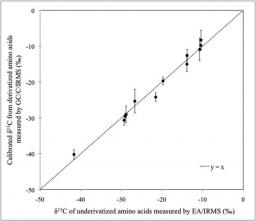
Fig. 1 Calibration curve for δ13C values of underivatized commercial amino acids measured off-line (EA/IRMS) versus the derivatized ones measured by GC/C/IRMS and calibrated by the dilution factor. Every point represents the mean of triplicate measurements in GC and EA. Error bars represent propagated errors; Error bar on EA/IRMS δ13C value is smaller than symbol.
RATIONALE: Compound-specific stable carbon isotope analysis by GC/C/IRMS is widely used in studies of environmental or biological functioning. In the case of derivatized molecules, a calibration might be required due to added non-analyte carbon and in some cases non-stoichiometric recovery by the mass spectrometer.
METHODS: Two biological materials of known isotopic composition were produced by microbial cell cultures on either 13C-labelled glucose or non-labelled glucose as sole source of carbon. Subsequent hydrolyzed amino acids were derivatized as tert-butyldimethylsilyl (tBDMSi) derivatives and analyzed by GC/C/IRMS. The 13C-enrichment measurements were used as a direct calibration to calculate the original 13C/12Cratios of individual amino acids.We tested this calibration on both known and unknown samples.
RESULTS: For the main proteinogenic amino acids we could determine the number of non-analyte added carbon atoms and assess the non-stoichiometrical recovery of tBDMSi carbon atoms, due to their incomplete oxidation in the combustion step of GC/C/IRMS. The calibration enabled the determination of the natural abundances (d13C values) of amino acids with an average accuracy of ±1.1‰.
We illustrate the application of the calibration to determine the 13C/12C ratios of amino acids, and the associated uncertainty, in biological and plant materials.
CONCLUSIONS: The analysis of a labelled microbial cell culture offers a straightforward, rapid and reliable estimate of non-analyte carbon contribution to stable isotope composition. We recommend this method as a calibration or a control in artificial or natural 13C-tracing experiments.
Kheirbeik Louay, Hatté Christine, Balesdent Jérôme
Reference : Rapid Comm. in Mass Spectrometry, 2016, 30, 1991-2001.






